15 tips all social media managers need to know
A whopping 84.3% of the UK population is active on social media – so if you’re a marketer, it’s a no-brainer to use social media to reach your audience.
But while some people believe that social media is instinctive, using social for marketing – and doing it well – can be difficult. With 30 June marking Social Media Day, we asked social media and digital marketing experts their top tips to create amazing social media marketing that gets results.
Read on for 10 in-depth tips you need to know if you work in social media…as well as five additional bite-size tips!
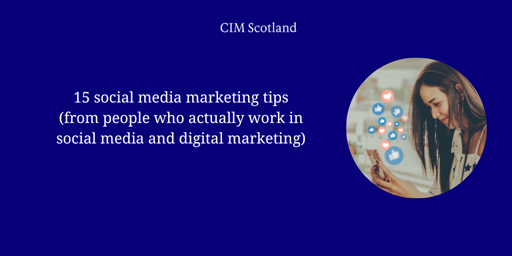
Plan your social media strategy
It’s easy to set up a social media account and just start posting. However, sending random posts without a plan won’t help you achieve your goals – whether those are raising awareness of your business, getting more people to engage with you, or driving sales. In order to be successful, you need to create a social media strategy.
This helps you plan who you want to talk to, what you want to say, and what you want to get out of it.
Amanda Burns, Head of Business Development at Flourish Marketing, explained: “I think a lot of us forget what social media is when it becomes our job. We get so caught up ticking the various actions associated with social media management off our to-do list; content writing - tick, creative briefing - tick, scheduling - tick. My advice, particularly for those who are agency side, is to build in the time to proactively stand back and look at your strategy and the tactics you need to implement to achieve your goals.
“After you’ve thought about objectives, think about the pillars you want to hit - these might include highlighting client/customer testimonials, demonstrating a sector specialism or sharing your thought leadership content. Next, ask yourself ok, how do I do that? What are the trending tactics to deliver the message? What does the creative need to look like? What are the latest technologies available on social networks that will help me put this message in front of my target audience?”
Don’t assume social media is just for brands that sell
When people say ‘social media marketing’, many think of fast-moving consumer goods (FMCG) or clothes – but social media can be used by the private sector, charities and the public sector.
In fact, social media is great for the public sector as it allows councils, schools, hospitals and more to share information on a much wider basis, in real time, than they ever could before.
Mhari Burley, Senior Communications Officer (Marketing and Digital) for North Ayrshire Council, agrees: “Social media and the public sector ‘should’ go together like peas and carrots. Why? Because it is an excellent place to engage with communities, encourage behaviour change and from recent experience, it is essential for crisis communication. I lead a marketing team in a Local Council and daily we strive to produce relatable content that our audiences will understand, engage with, and enjoy.
“Yes, social media can be used to inform and educate people about Council services but what I think is key to success is personality. Showcase who you are and put faces to your services - social media is about people after all. It really helps bring organisation priorities and service delivery to life.
“Focus your energy on the right platforms, learn what works and engage. Build credibility and trust by keeping your channels fresh and actually talk to those who follow you.”
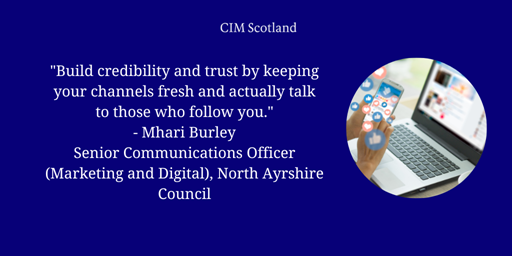
Use paid and organic social media in harmony
‘Organic social media is dead!’ – it’s a phrase you’ve probably heard someone say if you work in the social media or digital marketing industry.
It’s true that in some cases organic reach is declining (as of 2020, Facebook posts reach an average of 5.2% of followers… down from 7.7% in 2018) but that doesn’t mean it’s not worth using: just that you need to focus your efforts. A combined organic and paid approach can be particularly useful.
Digital marketing executive Jessica Williams agreed, stating: “Never underestimate the power of a Gemini approach to social media strategy – the perfect synergy between paid and organic has a strength like no other.
“There are few other ways you can directly target your buying committee than paid social media, and the growing popularity of an account based marketing approach is the perfect time to ‘sell’ the knowledge we have all known for years around the vigour the channel can have for all verticals.
“However, the urban myth that you can cheat the algorithm by paying your way into peoples feed and see results in that way alone is exactly that – a myth. A strong organic presence is key for building trust with your communities, and this is vital to have running alongside your paid strategy with consumers growing more skeptical due to the rise of the influencer.
“Social media, and the digital space as a whole, for brands is following the steps of natural selection. Evolve to stay relevant by keeping up to date with trends and customer expectations, or be left behind – our time to showcase our expertise is now!”
Don’t forget the importance of engagement
Despite being called SOCIAL media, too often companies fall into the trap of ‘posting and ghosting’ – that is, posting, but not bothering to engage with those who reply.
Kal Durand, Social Media Reputation Manager at Sage, wants to see this change: “Social media, it’s in the name. The foundation of the platforms that have become an ingrained part of our daily lives is the idea of being social, it’s literally what they were built for. It's the ability to connect, to share, to exchange views and to be part of a community; and that should not be forgotten. Often brands lose touch with this, as targets set by senior stakeholders to increase sales become the tunnel vision focus of social media managers.
“Paid campaigns with a focus on conversion play a key part in any business and definitely have their place, but, at the end of every sale is another human being, and all humans love to feel loved. The one piece of advice I would give any brand is to understand the importance of engagement in creating brand loyalty. How you interact and have value in what you publish, is just as powerful as your glossy new ad, if not more. Show that you are listening, show that you understand their world and make them feel like they are part of your business rather than just another customer.”
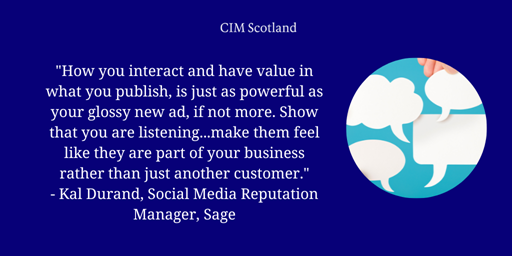
Try a ‘test and learn’ approach
Once you’ve created a social media strategy or plan, it can be easy to just stick with the same formula. However, things change, and new formats and trends come to the forefront, so it is worth trialing different things.
Alison Bruce, Brand Communications Manager for BBC Alba, suggested: “If you notice consistent drops in engagement, don't be afraid to try new strategies to re-connect with your audience. Use A/B testing to try out new ideas.”
A/B testing allows you to see what version performs better. There are a variety of things you can A/B test, from whether the copy is short or long; if you use an image or a video; even things as little as posting at different times of day. Remember that you should only test ONE thing in each A/B test: if one post is a video with one line of text going out at 9am, and the second is an image with four paragraphs that you post at 6pm, you won’t be able to tell what the deciding factor is for the ‘winning’ post.
Use a mix of content formats
When you are on social media, what attracts you to a post? Is it the text that grabs your eye first…or the image/video that goes with it? Chances are, you said the latter.
That’s why it’s so important to make sure that you have a range of high-quality images and videos to use across your suite of social media, to be used in everything from TikToks to LinkedIn images to Instagram Stories.
Emma Degnan, Marketing Manager at RBH, said: “Integrate a range of media into your content strategy: Think outside the box when it comes to choosing the format of your content. Mix it up by using pre-recorded video, reels, text, still image, live video and gifs. Studies show that 54% of consumers want to see more video content from a brand or business they support (HubSpot). Video can be used in a range of ways now, with pre-recorded short videos or creative reels to showcase your brand.
“The popularity of video content has been on the rise for many years, especially through the Covid-19 pandemic when many brands looked at a virtual-only approach during that time. As great as video is, even in 2022 a picture is still worth a thousand words. Consider investing in a new suite of still images by conducting a brand photoshoot with a professional photographer. Your new images could provide years of content not only for social media, but for print and use on your website too.
“Ultimately, I would always recommend varying your content across your social platforms. By having a mix of media and formats it can keep your followers engaged and interested in your message, and help your account stand out against others.”
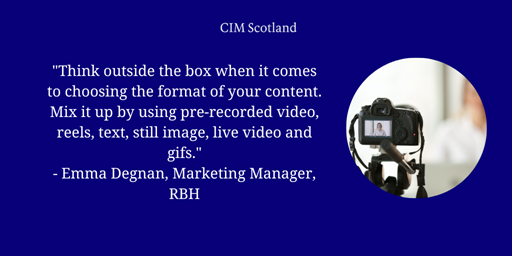
Know your audience and tailor your content
Depending on who you are targeting on social media, what you say and what platforms you use will be very different.
You should already know the demographics, interests, and needs of your ideal audience through your marketing or social media strategy, but it’s important you don’t forget this. Use that information to make sure you’re in the same place that they are and tailoring your content to them.
Hayley Duncan, Senior Marketing Executive with Allegis Group, explained: “Effectively navigating social media and its complex algorithms is both an art and a science. To keep it simple, always start with your audience in mind and this will help determine both the platform you use and the type of content post. Ask yourself – who am I targeting? and where are they? Positioning content where your audience are at is key. For example, if you are targeting a hiring campaign at Generation Z, then you might focus on platforms like Instagram, TikTok and Snapchat for your content. Whereas for B2B sales, you may choose to utilise LinkedIn.
“Once you know your audience, and have picked your platform, then it’s about tailoring your content accordingly. Where Instagram might show your company or business culture using fun and engaging videos and visuals, LinkedIn might be the best place to share business updates, industry insights or other corporate content. Managing multiple social media channels can be a very time-consuming task and takes lots of planning – don’t be afraid if you decide against a particular platform. It’s better to post at a consistent cadence on one or two key channels than spreading your efforts thinly across multiple.”
Check your posts provide value
Social media shouldn’t just be sales posts. There should be something in it for the viewer, that makes it worthwhile for them to follow you: it needs to provide value.
Those active on ‘marketing Instagram’ or ‘marketing TikTok’ will have heard this tip mentioned…but a lot of the time they don’t explain what it actually means.
Mark Donachie, Marketing Manager at Glasgow Credit Union, breaks it down: “My number-one suggestion to social media managers would be to focus their social media efforts on providing value to their target audience. Value is at the heart of every purposeful social media strategy. Creating value comes in numerous forms, from educational and inspiring to entertaining and relatable. When creating your social media strategy goals and objectives, think about how you can achieve these goals using a value-based approach. By putting yourself in the shoes of your consumer, you can decipher and understand their needs and wants. Moreover, you can start creating content that targets these specific areas.
“Value builds trust, credibility, and brand awareness and can even help you forge an emotional connection with your audience. Social media marketing in 2022 is more competitive than ever, especially with ever-altering formats and algorithm changes. However, something that will never change is that consumers will always have desires and problems, and it is up to us as social media managers to help provide solutions.”
To properly provide value, aim to make sure each post either entertains, educates, inspires or persuades.
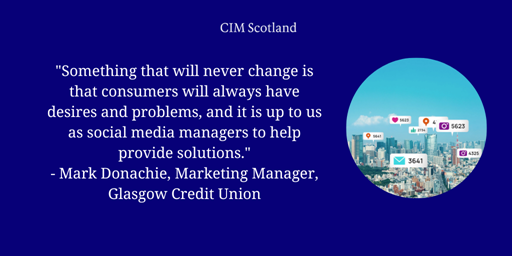
Use insights to get the most out of social media
It’s not enough to just post on social media: you need to analyse the results to see what works and what doesn’t. This can help you plan what to focus on in the future, and allows you to see what social posts are leading to engagement, web clicks, and even sales – on both organic and paid content.
Ishbel Macleod, Head of Research and Insights at Hydrogen, said: “Working at a social media agency, we get asked a lot about results: clients understandably want to know what effect social media is having on their business. It’s incredibly important for social media managers to track things like follower growth, average post impressions (the number of times a post was seen), average post engagement, engagement rate, clicks and more.
“If you work in a silo on social media, it may seem a waste of time to track these – but I promise it isn’t. It can help you see what works best so you can plan for the future, tell you in a campaign is working, and even see if there are peak periods to post. For example, did you know that many companies see a dip in social media engagements across summer? This is due to people being on holiday and out enjoying the sun…so they aren’t scrolling on their social feeds as much. Being able to see and predict trends across your social media can help you save time, see what works…and help you get the best possible results out of social media.”
And finally…you don’t need to do it alone!
Despite the word ‘social’ being in its name, social media manager can be a lonely profession for some, especially if they are the only person in a business charged with marketing efforts. But don’t feel like you need to do everything yourself. Other employees – and even those who follow the rand on social media – can be an excellent source of ideas, just waiting to be tapped!
Sophie Craik, Digital Communications Manager at Creative Scotland, said: “A key I’ve found to planning content is first acknowledging that you can’t be in all places at once, nor know all of the things.
“Chances are though, you’re working with people who would love to have a say on what goes out on the channels! Utilise that enthusiasm and harness some employee advocacy at the same time.
“Having a really clear process for suggesting content ideas can help to ensure you’ve got all the information you need (in the timescales you would need it by), while getting really valuable insights from those close to different areas of the work you’re talking about.
“People are more likely to share something that feels relevant to them, so they may well be more inclined to show support for the brand if they spot a suggestion they put forward making its way onto the channels.”
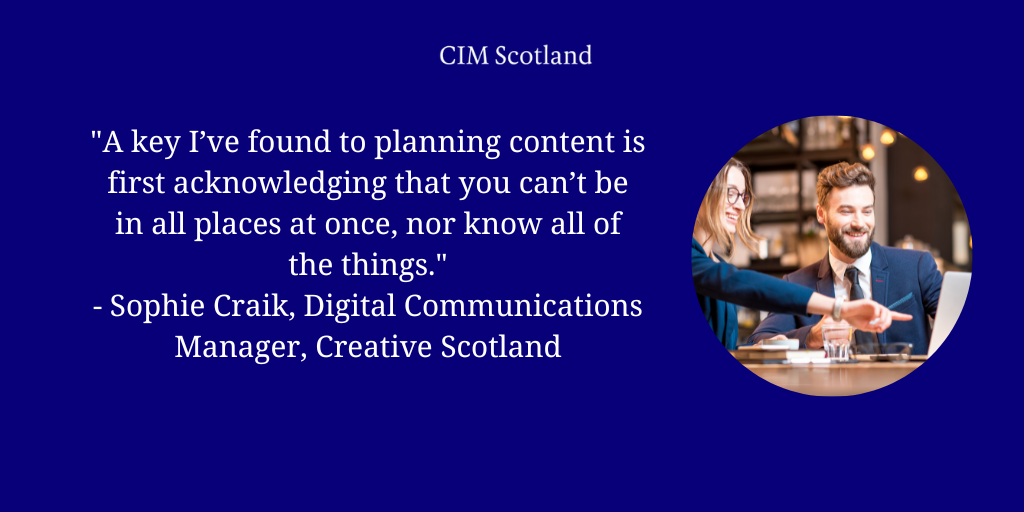
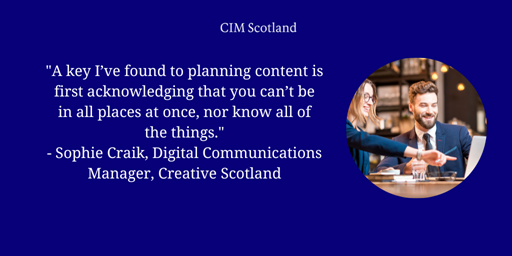
Here are five additional bite-size tips to consider:
- “My top tip would be to check your spelling before posting” - Dr Noreen Siddiqui, Senior Lecturer in Marketing, Glasgow University
- “Trust social media managers to make decisions, especially if you're pushing a social media strategy which relies on being reactive and relevant” - Alison Bruce, Brand Communications Manager, BBC Alba
- “Asking if something is right for the brand and if there’s capacity to make it a success, and committing to doing a few things well rather than all the things on burnout mode is essential” - Sophie Craik, Digital Communications Manager, Creative Scotland
- “Don’t forget to make sure your posts are accessible: add alt-text on images, make sure videos have captions. This helps people with visual or hearing issues to enjoy your content” – Ishbel Macleod, Head of Research and Insights, Hydrogen
- “Paying for advertising enables you to segment your market and should extend the reach of your content to groups outwith your existing following, in turn bringing more people to your page and (over time and done well) boosting engagement” - Hayley Duncan, Senior Marketing Executive, Allegis Group

